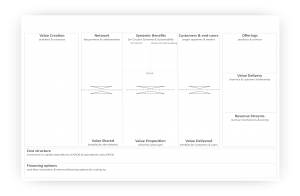

About the tool
The Circular Economy Business Model Framework can help you to translate an idea into a complete Circular Economy business model concept/configuration. Use this tool to detail how each element of the business model should look like. It is important to have a Circular Economy business model idea and a value proposition before using this tool.
For more information about the Circular Economy Business Model Framework and how it was developed, read this article.
How to apply the tool?
The Circular Economy Business Model Framework can be filled in using the following steps:
Step 1:
Document the systemic benefits, value proposition, customer & users, and value delivered (i.e. benefits for customers and users).
Step 2:
Explain how the value proposition will be provided by configuring the other elements of the business model. A recommendation of order for filling in the elements is available in the workbook.
Step 3:
Explore the viability of alternative configurations by identifying variations in the design options for each of the business model elements. Check the Expert System Circular Economy Business Model Configurator for some tips.
Step 4:
Check consistency among elements and use the Checklist of Sustainability Qualifying Criteria to improve the configurations.
Step 5:
Create and test virtual prototypes of the alternative configurations to investigate assumptions.
Step 6:
In case of multiple business model configurations, a round of prioritisation is recommended.
When to apply the tool?
The Circular Economy Business Model Framework should be used in the seize stage to help defining and refining how the new business model(s) will look like.

The Circular Economy Business Model Framework is one of the tools presented in the CIRCit project to help in the development of Circular Economy Business Models (WP2). Read more about the results of this focus area, explore other tools and download the inspiring workbook here.
Downloads
